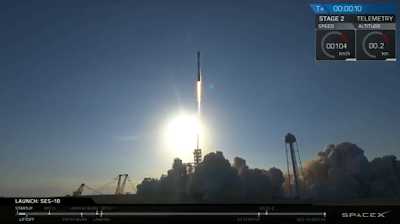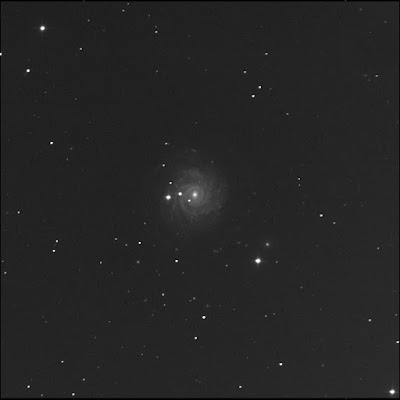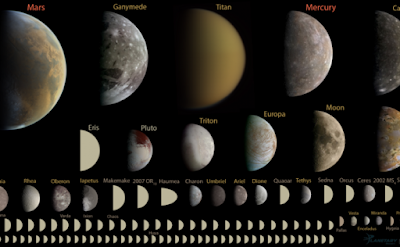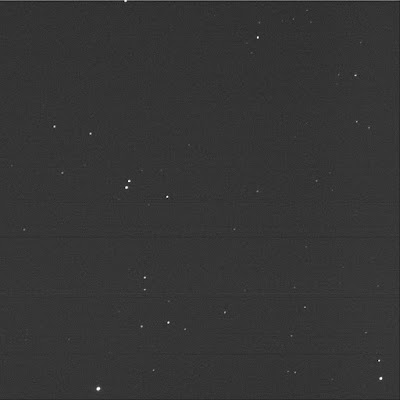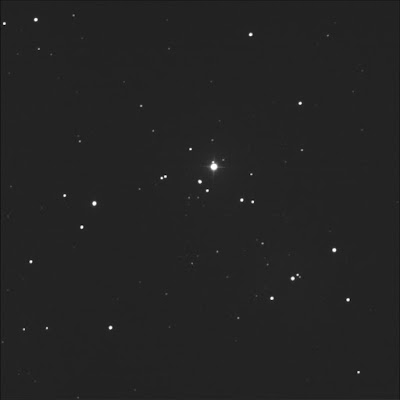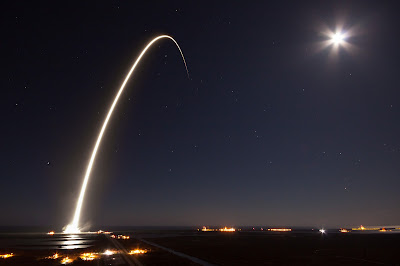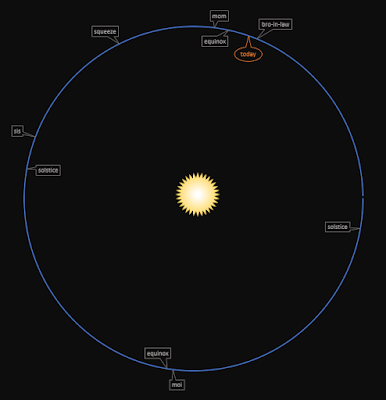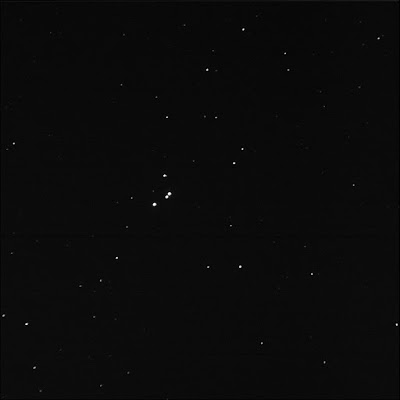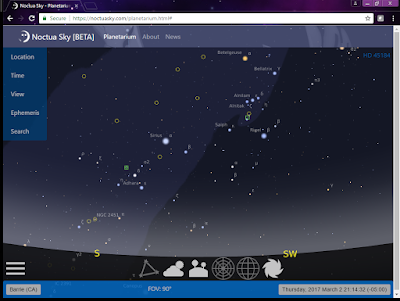Noctua Sky was updated to show some asteroids and minor planets.
§
The location detection seems to be working better...
Friday, March 31, 2017
don't mess with a red giant
I don't remember how I came across this artwork by Jackie Moliner. Must have been a shared item on Facebook. Nevertheless, her Types of Stars is fun and light (no pun intended).
Copyright © 2017 Jacqueline Moliner. Used with permission.
Check out the New York artist's online portfolio for other fun works, many with an astronomical theme.
Check out the New York artist's online portfolio for other fun works, many with an astronomical theme.
WDS down?
I tried to access the Washington Double Star database. It does not seem to be working...
Labels:
double stars,
software
buttoned up mount
Did some more testing with the GoToStar (IDEA/iOptron) system on the Vixen Super Polaris mount.
With the custom bracket (made by Jeff) installed with the appropriate bolts I was able to place the GoToStar Dec motor in its proper position. Used the old flat plate (made by Tony) to hold the motor assembly to the Dec bracket.
I had screwed up in the bracket design by not accommodating for the ridges on the top of the motor casing. But it occurred to me that this was not a show-stopper. In fact, I wondered if it would prove useful.
I put rubber band pieces between the outboard part of the bracket and the motor to serve as something of a shock absorber. The motor assembly could move a bit for imperfections in the gears. The rubber strips, cut from a thick but small broccoli elastic, would act as a spring, pressing the gears together.
Boxed everything up. Used a recycled food container as a protective cover over the Declination motor assembly as I put the mount in the carrying case. That's until I can make (or print in 3D) a new custom cover.
With the custom bracket (made by Jeff) installed with the appropriate bolts I was able to place the GoToStar Dec motor in its proper position. Used the old flat plate (made by Tony) to hold the motor assembly to the Dec bracket.
I had screwed up in the bracket design by not accommodating for the ridges on the top of the motor casing. But it occurred to me that this was not a show-stopper. In fact, I wondered if it would prove useful.
I put rubber band pieces between the outboard part of the bracket and the motor to serve as something of a shock absorber. The motor assembly could move a bit for imperfections in the gears. The rubber strips, cut from a thick but small broccoli elastic, would act as a spring, pressing the gears together.
Boxed everything up. Used a recycled food container as a protective cover over the Declination motor assembly as I put the mount in the carrying case. That's until I can make (or print in 3D) a new custom cover.
Thursday, March 30, 2017
another first
SpaceX did it! Another precedent-setting day, they launched the SES-10 satellite atop a previously-flown booster. Then they recovered the booster, again, on their at-sea barge. An incredible achievement.
Lifting off.
Well clear of the tower.
The used Merlin engines running at full power.
Rolling.
Around Max-Q.
After MECO.
Stage 1 decent burn; stage 2 motor running.
Stage Falcon 9 back on the Earth.
SES-10 heading to orbit.
Access to space just got cheaper.
You can watch the SpaceX video of the launch through landing.
Spaceflight Now shared photos and video captured from the press site.
§
Spaceflight shared some very nice hi-rez photos from sound-triggered cameras.
SpaceX updated their flickr images. Now there are hi-rez still shots of the landing.
§
Video (with audio) from the drone ship showed up on Instagram.
Not my imagination: the fins did glow red-hot on this descent. They are aluminium coated in heat shield material. Future fins will be made of forged titanium.
Lifting off.
Well clear of the tower.
The used Merlin engines running at full power.
Rolling.
Around Max-Q.
After MECO.
Stage 1 decent burn; stage 2 motor running.
Stage Falcon 9 back on the Earth.
SES-10 heading to orbit.
Access to space just got cheaper.
You can watch the SpaceX video of the launch through landing.
Spaceflight Now shared photos and video captured from the press site.
§
Spaceflight shared some very nice hi-rez photos from sound-triggered cameras.
SpaceX updated their flickr images. Now there are hi-rez still shots of the landing.
§
Video (with audio) from the drone ship showed up on Instagram.
Not my imagination: the fins did glow red-hot on this descent. They are aluminium coated in heat shield material. Future fins will be made of forged titanium.
Labels:
SpaceX
readied for SES-10
Started watching SpaceX launch... using the SpaceX video/audio feed and the blog feed at Spaceflight Now. This could be another historical event.
Labels:
SpaceX
she raised the bar
Peggy Whitson broke the spacewalk record for women today. She's awesome. During her eighth spacewalk outside the International Space Station, she surpassed Sunita Williams record.
Labels:
NASA
spotted zeros
Spotted a bug in Noctua Sky.
When you click a planet and the info box appears or updates, all is well. That is, all the information shows, as expected. But if you click a star, the distance, RA/Dec, and Az/Alt show as zeros.
Interestingly, if you change the time, the missing values appear. So, if you really need them, go forward one hour then back to the original time. A little workaround.
§
Reported it.
§
Guillaume responded. He's looking into it.
When you click a planet and the info box appears or updates, all is well. That is, all the information shows, as expected. But if you click a star, the distance, RA/Dec, and Az/Alt show as zeros.
Interestingly, if you change the time, the missing values appear. So, if you really need them, go forward one hour then back to the original time. A little workaround.
§
Reported it.
§
Guillaume responded. He's looking into it.
Labels:
software
Tuesday, March 28, 2017
done shaking
The James Webb Space Telescope (JWST) completed its acoustic and vibration tests. Another milestone reached. This is well-documented at the NASA web site. Still on track for its 2018 launch.
found bolts
Noticed them before in a parts bin but finally got 'round to trying them. The machine bolts with proper thread. And small heads. They fit! Mounted the custom Declination plate. Then mounted the motor. I think it will work....
Monday, March 27, 2017
got galaxy NGC 3344 (Halifax)
The Burke-Gaffney robot imaged NGC 3344. A face-on galaxy in Leo Minor. One of the RASC Finest NGCs.
Luminance only, 60 seconds subexposures, 10 stacked shots. FITS Liberator, Paint.NET. North is up; east is left.
To the north-west, near the top-right corner of the image, is a small oval fuzzy. LEDA 1723912 is just east of the star J104244.5+250255.
There is a sprinkling of tiny fuzzy points to the west of the big galaxy but these are not identified in SkyTools 3 Pro.
I see a bright round lint ball to the west-south-west of 3344, up and right of the bright star SAO 81487. An elliptical galaxy perhaps. LEDA 1718878.
LEDA 1718826 and LEDA 1718896 are north-east of the bright star, between it and the galaxy. 1718826 is further away from the spiral, closest to the star, and is very small. The size of nearby stars but with a soft appearance. 1718896 has a slight oval shape.
There are more unmarked distant galaxies to the south. For example, I see an oval where ST3P says J104326.4+244844 is located.
LEDA 1717186 is to the south-south-east of NGC 3344 and east of the star GSC 01977-0705. A tiny canted almond shape.
LEDA 1718221 is south-east of 3344 and due south of GSC 01977-0730. Nearly perfectly round. Very small again.
Tiny round LEDA 1719450 is due east of the large spiral, at the edge of the frame, just beyond GSC 01977-0846.
Another small round fuzz shows east-north-east of NGC 3344. LEDA 1721382 is just west of GSC 01977-0899.
I think, overall, I can see another dozen galaxies in this image.
Immediately left or east of the galaxy core is the bright, wide double star SAO 81492. The A member is superimposed over an outer arm of the spiral; B is between it and the bright hub of the wheel.
§
Wikipedia link: NGC 3344.
Luminance only, 60 seconds subexposures, 10 stacked shots. FITS Liberator, Paint.NET. North is up; east is left.
To the north-west, near the top-right corner of the image, is a small oval fuzzy. LEDA 1723912 is just east of the star J104244.5+250255.
There is a sprinkling of tiny fuzzy points to the west of the big galaxy but these are not identified in SkyTools 3 Pro.
I see a bright round lint ball to the west-south-west of 3344, up and right of the bright star SAO 81487. An elliptical galaxy perhaps. LEDA 1718878.
LEDA 1718826 and LEDA 1718896 are north-east of the bright star, between it and the galaxy. 1718826 is further away from the spiral, closest to the star, and is very small. The size of nearby stars but with a soft appearance. 1718896 has a slight oval shape.
There are more unmarked distant galaxies to the south. For example, I see an oval where ST3P says J104326.4+244844 is located.
LEDA 1717186 is to the south-south-east of NGC 3344 and east of the star GSC 01977-0705. A tiny canted almond shape.
LEDA 1718221 is south-east of 3344 and due south of GSC 01977-0730. Nearly perfectly round. Very small again.
Tiny round LEDA 1719450 is due east of the large spiral, at the edge of the frame, just beyond GSC 01977-0846.
Another small round fuzz shows east-north-east of NGC 3344. LEDA 1721382 is just west of GSC 01977-0899.
I think, overall, I can see another dozen galaxies in this image.
Immediately left or east of the galaxy core is the bright, wide double star SAO 81492. The A member is superimposed over an outer arm of the spiral; B is between it and the bright hub of the wheel.
§
Wikipedia link: NGC 3344.
Labels:
Apogee,
double stars,
galaxies,
NGC,
photography
Saturday, March 25, 2017
processed 1 Cam in colour
Processed 1 Cam aka STF 550 in full colour using the LRGB data from 18 Mar '17.
Luminance 4x10, RGB 4x5 each. FITS Liberator and Photoshop. North is up; east is left.
A and B look blue-white. C, to the south-west, looks pale blue. SkyTools 3 Pro shows it as orange and reports the B-V as 2.1. Huh.
Luminance 4x10, RGB 4x5 each. FITS Liberator and Photoshop. North is up; east is left.
A and B look blue-white. C, to the south-west, looks pale blue. SkyTools 3 Pro shows it as orange and reports the B-V as 2.1. Huh.
Labels:
double stars
Friday, March 24, 2017
looking up and ahead
Checked Noctua Sky again. A new feature was added: the Calendar. This displays a listing of interesting astronomical events for the current month. It appears to use the current location too. This makes the web-based planetarium good for observing what's happening right now as well as planning for future events.
Thursday, March 23, 2017
Tuesday, March 21, 2017
all round objects
It seems the what-is-a-planet debate is heating up again. A relatively new proposal to me is that if you have a sufficiently large body, with strong enough gravity, to form a roughly spherical shape, that can be called a planet. That would allow Pluto (and Charon) into the planet club again. I heard that this (or a similar) proposal ignores an orbital aspect, saying the body must orbit the Sun. That seems odd for then that would make moons of planets considered planets. And that doesn't sit with me.
Kirby Runyon's definition is noted in an article at Universe Today. His definition includes any non-fusion body. That could mean that our solar system then has over 100 planets!
§
Image from Emily Lakdawalla of the Planetary Society, data from NASA / JPL, JHUAPL/SwRI, SSI, and UCLA / MPS / DLR / IDA, processed by Gordan Ugarkovic, Ted Stryk, Bjorn Jonsson, Roman Tkachenko, and Emily Lakdawalla.
Kirby Runyon's definition is noted in an article at Universe Today. His definition includes any non-fusion body. That could mean that our solar system then has over 100 planets!
§
Image from Emily Lakdawalla of the Planetary Society, data from NASA / JPL, JHUAPL/SwRI, SSI, and UCLA / MPS / DLR / IDA, processed by Gordan Ugarkovic, Ted Stryk, Bjorn Jonsson, Roman Tkachenko, and Emily Lakdawalla.
Monday, March 20, 2017
plus and minus
Malcolm wished me a happy equinox! He couldn't remember if I liked the spring equinox or not. It's complicated.
Labels:
friends and family,
weather
Sunday, March 19, 2017
constellation Suds
Errand day. Helped return many empties. Rhonda asked for suggestions for picking up something. I showed her the microbrewery section. I spotted the winter Survival Pack by Muskoka Brewery. Neat. Constellation stick figures on top.
Rhonda noted the interesting bottle-shaped figure. Now that's a constellation I can relate to.
Rhonda noted the interesting bottle-shaped figure. Now that's a constellation I can relate to.
Labels:
beer,
constellations,
friends and family,
fun
procured HR 6246 (Halifax)
The Burke-Gaffney robot tagged the multi-star system HR 6246 aka in Σ2103 Hercules, centring on Tycho 00974-0733 1.
Luminance only, 6 seconds subexposures, 10 stacked shots. FITS Liberator, GIMP. North is up; east is left.
When I first viewed this system on the evening of 22 May '15, I did not spot the C star. While B is too close to bright A in the image, C is obvious at the 4 o'clock position (i.e. south-west), close, with D, away, at 7 o'clock (or south-east).
§
Stretched dramatically with the x1/2 function. The B star emerged!
Zoomed/cropped. B is at the 10 o'clock position.
§
Processed in colour on 6 May '17.
Luminance only, 6 seconds subexposures, 10 stacked shots. FITS Liberator, GIMP. North is up; east is left.
When I first viewed this system on the evening of 22 May '15, I did not spot the C star. While B is too close to bright A in the image, C is obvious at the 4 o'clock position (i.e. south-west), close, with D, away, at 7 o'clock (or south-east).
§
Stretched dramatically with the x1/2 function. The B star emerged!
Zoomed/cropped. B is at the 10 o'clock position.
§
Processed in colour on 6 May '17.
Labels:
Apogee,
double stars,
photography
Saturday, March 18, 2017
think I got HJ 3318 (Halifax)
Asked the BGO robot to aim at GSC 02509-0146 near where I thought the neglected double star HJ 3318 might be. In Leo Minor. Thar she blows.
Luminance only, 3 seconds subexposures, 10 stacked shots. FITS Liberator, GIMP. North is up; east is left.
I selected this pair from the Washington Double Star database. A is to the south; B to the north.
HJ 3318 is listed in the WDS as having a theta value of 340 and rho of 24.8. This is very close to the numbers in SkyTools 3 Pro: PA 340° Sep 24.00" (as of 1906). The Interactive Atlas chart displays the stars with the correct orientation and spacing. The chart is nearly a perfect match to the image.
In the Object Information box, ST3P says A is magnitude 11.03 and B 9.7. That doesn't seem right. On hovering over the stars in the chart, the numbers are 11.0 and 11.9. The chart shows A as slightly brighter. The WDS says they are mag 9.3 and 9.7 stars. The image gives the impression that B is very slightly dimmer than A. The stars in the image closely match the brightnesses of TYC 02509-0907 1 (11.17) and TYC 02509-0844 1 (11.61) to the north. This leaves me with the impression that the WDS magnitudes are incorrect.
The big issue, it seems, is the location. WDS says the pair is at RA 10:02.7 and Dec +36:15. ST3P shows the pair at RA 10:03:42.8 and Dec +36:15:06 (J2000). If I had to say, it looks like the original entry had a transcription error in the Right Ascension, 2 minutes instead of 3. The stars in the image match ST3P. They are between J100338.4+361610 (to the north-west) and J100344.9+361424 (to the south-east).
Luminance only, 3 seconds subexposures, 10 stacked shots. FITS Liberator, GIMP. North is up; east is left.
I selected this pair from the Washington Double Star database. A is to the south; B to the north.
HJ 3318 is listed in the WDS as having a theta value of 340 and rho of 24.8. This is very close to the numbers in SkyTools 3 Pro: PA 340° Sep 24.00" (as of 1906). The Interactive Atlas chart displays the stars with the correct orientation and spacing. The chart is nearly a perfect match to the image.
In the Object Information box, ST3P says A is magnitude 11.03 and B 9.7. That doesn't seem right. On hovering over the stars in the chart, the numbers are 11.0 and 11.9. The chart shows A as slightly brighter. The WDS says they are mag 9.3 and 9.7 stars. The image gives the impression that B is very slightly dimmer than A. The stars in the image closely match the brightnesses of TYC 02509-0907 1 (11.17) and TYC 02509-0844 1 (11.61) to the north. This leaves me with the impression that the WDS magnitudes are incorrect.
The big issue, it seems, is the location. WDS says the pair is at RA 10:02.7 and Dec +36:15. ST3P shows the pair at RA 10:03:42.8 and Dec +36:15:06 (J2000). If I had to say, it looks like the original entry had a transcription error in the Right Ascension, 2 minutes instead of 3. The stars in the image match ST3P. They are between J100338.4+361610 (to the north-west) and J100344.9+361424 (to the south-east).
Labels:
Apogee,
double stars,
photography
imaged 15 Mon (Halifax)
BGO captured multi-star system 15 Monocerotis, aka Σ950, centered on GSC 00750-1865. I viewed this system in early-April '13 but did not identify all of the elements.
Luminance only, 2 seconds subexposures, 10 stacked shots. FITS Liberator, GIMP. North is up; east is left.
The B star is too close to bright A to split, unfortunately.
C is deliciously close to A, to the north.
D is easily spotted to the right of C, north-west of A. It is very faint. I had not seen this before.
Not sure what to say about E. There certainly seems to be a magnitude 11 star is the correct place. But SkyTools 3 Pro says the variable V343 Mon is south of E. Nothing shows in the image. Perhaps SkyTools is wrong in showing 2 stars; maybe there's only 1 and it is the variable and it was quite dim when I looked before.
F and G are south of E, brighter than E. F is on the east while dimmer G is to the west. This pairing is well away from AB to the south-west. F is slightly further away than E.
South-east of AB is the touching, unequal pairing of H and I.
South-west of HI is J, almost due south of AB. J appears the same mag as G. This star is also known as D11.
K is north-east of AB, opposite E, slightly closer than E. K is dimmer than G but brighter than C.
L and M are the close pair of equal stars to the east-south-east of AB. They also seem the same brightness of G. The M star appears to have another designation: Σ952.
N is south of HI. It is much dimmer. I had not seen N before.
O is due east of N. Very slightly brighter than N. aka V810 Mon.
Finally, U is to the north of A, B, and C. U looks to be the same magnitude as N. aka JRN 30.
That was awesome. Spotted 2, possibly 3, more stars of this interesting system.
To the east-south-east of the 15 Mon system is the bright triangle of HD 262066. This is a quad. A and B are on top of one another at the south apex and not splittable in the image. Too bad. I did not split them in 2013. This will remain on the View Again list. C is the west point and is brighter. D is north-east of HD 262066 AB.
To the south-west of 15 Mon is V684, a quintuple. A, B, and C, form a compact triangle. D is to the south-east of A, slightly dimmer than the primary. E is to the north-east of A, about the same separation as AD. E is dimmer than C.
Luminance only, 2 seconds subexposures, 10 stacked shots. FITS Liberator, GIMP. North is up; east is left.
The B star is too close to bright A to split, unfortunately.
C is deliciously close to A, to the north.
D is easily spotted to the right of C, north-west of A. It is very faint. I had not seen this before.
Not sure what to say about E. There certainly seems to be a magnitude 11 star is the correct place. But SkyTools 3 Pro says the variable V343 Mon is south of E. Nothing shows in the image. Perhaps SkyTools is wrong in showing 2 stars; maybe there's only 1 and it is the variable and it was quite dim when I looked before.
F and G are south of E, brighter than E. F is on the east while dimmer G is to the west. This pairing is well away from AB to the south-west. F is slightly further away than E.
South-east of AB is the touching, unequal pairing of H and I.
South-west of HI is J, almost due south of AB. J appears the same mag as G. This star is also known as D11.
K is north-east of AB, opposite E, slightly closer than E. K is dimmer than G but brighter than C.
L and M are the close pair of equal stars to the east-south-east of AB. They also seem the same brightness of G. The M star appears to have another designation: Σ952.
N is south of HI. It is much dimmer. I had not seen N before.
O is due east of N. Very slightly brighter than N. aka V810 Mon.
Finally, U is to the north of A, B, and C. U looks to be the same magnitude as N. aka JRN 30.
That was awesome. Spotted 2, possibly 3, more stars of this interesting system.
To the east-south-east of the 15 Mon system is the bright triangle of HD 262066. This is a quad. A and B are on top of one another at the south apex and not splittable in the image. Too bad. I did not split them in 2013. This will remain on the View Again list. C is the west point and is brighter. D is north-east of HD 262066 AB.
To the south-west of 15 Mon is V684, a quintuple. A, B, and C, form a compact triangle. D is to the south-east of A, slightly dimmer than the primary. E is to the north-east of A, about the same separation as AD. E is dimmer than C.
Labels:
Apogee,
double stars,
photography
captured 1 Cam (Halifax)
The Burke-Gaffney BGO robot imaged 1 Camelopardalis for me, centred on Tycho 03732-0038 1. A multi-star system in my View Again list. Also known as DL Cam and Σ550.
Luminance only, 4 seconds subexposures, 10 stacked shots. FITS Liberator, GIMP. North is up; east is left.
1 Cam is a triple, according to SkyTools 3. The A or primary star is the brightest star in the field, of course. B is also bright, to the north-west of A. I estimated 1 magnitude different; ST3P concurs.They are very tight; in this image, B touches A. C is much dimmer and well away to the south-west.
§
Not sure exactly why this was on my View Again list. While in a number of ST3P observing lists, I can find no records of viewing attempts. In a Sep 2016 list, it was tagged as high priority... Weird.
§
Assembled in full colour on 25 Mar '17.
Luminance only, 4 seconds subexposures, 10 stacked shots. FITS Liberator, GIMP. North is up; east is left.
1 Cam is a triple, according to SkyTools 3. The A or primary star is the brightest star in the field, of course. B is also bright, to the north-west of A. I estimated 1 magnitude different; ST3P concurs.They are very tight; in this image, B touches A. C is much dimmer and well away to the south-west.
§
Not sure exactly why this was on my View Again list. While in a number of ST3P observing lists, I can find no records of viewing attempts. In a Sep 2016 list, it was tagged as high priority... Weird.
§
Assembled in full colour on 25 Mar '17.
Labels:
Apogee,
double stars,
photography
imaged Messier 40 (Halifax)
It looks like I first viewed M40 (Messier 40, Winnecke 4) in July 2010. It seems the wide equal pair did not make a big impression on me. Still, I thought it might be fun to image it with the BGO 'scope, while the Moon was bright.
In preparing for the target, I noted orange star 70 UMa nearby. I decided to include it. For the first time, I tried the offset function with the robotic telescope commands. I told it to shift -15% in RA and -15% in Dec. It worked. 70 Ursae Majoris is at the bottom edge of the image.
Luminance only, 3 seconds subexposures, 10 stacked shots. FITS Liberator, GIMP. North is up; east is left.
There are hints of the faint nearby galaxies. Due west of the double star is the canted oval of NGC 4290. Beyond it: the smaller oval smudge of NGC 4284. Surprising, in a 3 second shot.
§
I didn't see this at first but SkyTools showed a small round galaxy to the west of the bright star. It's MCG 10-18-27 at magnitude 15.7 (in B). It is amazing to me that it is visible in such a fast exposure!
§
Wikipedia link: Messier 40.
In preparing for the target, I noted orange star 70 UMa nearby. I decided to include it. For the first time, I tried the offset function with the robotic telescope commands. I told it to shift -15% in RA and -15% in Dec. It worked. 70 Ursae Majoris is at the bottom edge of the image.
Luminance only, 3 seconds subexposures, 10 stacked shots. FITS Liberator, GIMP. North is up; east is left.
There are hints of the faint nearby galaxies. Due west of the double star is the canted oval of NGC 4290. Beyond it: the smaller oval smudge of NGC 4284. Surprising, in a 3 second shot.
§
I didn't see this at first but SkyTools showed a small round galaxy to the west of the bright star. It's MCG 10-18-27 at magnitude 15.7 (in B). It is amazing to me that it is visible in such a fast exposure!
§
Wikipedia link: Messier 40.
Labels:
Apogee,
double stars,
Messier,
photography
Friday, March 17, 2017
do science during the eclipse
With the coming grand total solar eclipse, there's lots of information coming available. There's some very cool items worth considering at the NASA Citizen Explorers web site. They are encouraging people to do science, regardless of where you are.
Labels:
Moon,
occultation,
planning,
science,
solar
Thursday, March 16, 2017
OK away
Heard that SpaceX got away OK. Another launch from pad 39A, this time for the EchoStar 23 satellite.
There was no planned retrieval of the first stage for this mission.
They have more photos on their flickr site.
Looking forward to the next SpaceX event, the planned SES 10 launch. This will feature a previously used rocket...
There was no planned retrieval of the first stage for this mission.
They have more photos on their flickr site.
Looking forward to the next SpaceX event, the planned SES 10 launch. This will feature a previously used rocket...
Labels:
SpaceX
Wednesday, March 15, 2017
Chereau edited the app
The friendly developer of Noctua Sky, Guillaume Chereau, encouraged me to send feedback. I let him know about some of the issues I was encountering with the web-based planetarium, particularly on the Android tablet. He affected some changes immediately!
He added zooming buttons in the toolbar and a close button for the info panel.
Very cool. Very interesting benefit of a cloud-based app...
He added zooming buttons in the toolbar and a close button for the info panel.
Very cool. Very interesting benefit of a cloud-based app...
Tuesday, March 14, 2017
7789 in colour
Put together NGC 7789 in colour using the LRGB data from 4 Aug '16. Surprising colour.
FITS Liberator, Photoshop CS2.
Luminance 60x10, RGB 60x5 each.
STI 3065 A appears white. I'm assuming B is the touching white star to the south-south-east, dimmer. There's a brighter pale orange due south of the lower white star.
STI 3063. The bright orange star to the north-east should be the primary with the dimmer grey star to the south-west. These are the opposite positions than what SkyTools shows.
Love the blue, white, and orange coloured stars, equally bright, in a straight line. ST3P only identifies one of these: GSC 04009-2108.
FITS Liberator, Photoshop CS2.
Luminance 60x10, RGB 60x5 each.
STI 3065 A appears white. I'm assuming B is the touching white star to the south-south-east, dimmer. There's a brighter pale orange due south of the lower white star.
STI 3063. The bright orange star to the north-east should be the primary with the dimmer grey star to the south-west. These are the opposite positions than what SkyTools shows.
Love the blue, white, and orange coloured stars, equally bright, in a straight line. ST3P only identifies one of these: GSC 04009-2108.
Labels:
NGC,
open clusters,
photography
made motors doc
Prepared and uploaded the small motors documentation for the CAO.
Labels:
RASC,
volunteering
Monday, March 13, 2017
next council meeting set
The next meeting of the RASC Toronto Centre council is scheduled for Thu 23 Mar. Location to be decided.
Labels:
planning,
RASC,
volunteering
happy orbit
Lately, I've been thinking about birthdays a bit differently. A birthday (or anniversary or any special event for that matter) is like a point along the orbital path of the Earth. As the Earth spins around the Sun, it approaches and travels through these points. And we, on our little blue ball, celebrate (or reflect or mourn or acknowledge).
They are like rendezvous. Appointments in time. Along the way.
They are like rendezvous. Appointments in time. Along the way.
Labels:
friends and family,
fun,
solar
Saturday, March 11, 2017
BGO annivesary
One year. It's been one year that I have been imaging with the robotic telescope at Burke-Gaffney Observatory in Halifax. Over 370 objects—including galaxies, double stars, globular clusters, nebulae, open clusters, planetary nebula, comets, dark nebulae, quasars—identified. It's been a ton of fun. Still learnin' lots.
Labels:
Apogee,
equipment,
photography
NZ Post features aurora
The New Zealand Post just issued some lovely stamps for post mail featuring the aurora australis.
Well done.
They also are offering the Southern Lights Silver Proof Coin which shimmers with its holographic image.
Well done.
They also are offering the Southern Lights Silver Proof Coin which shimmers with its holographic image.
Friday, March 10, 2017
HJ 207 in colour
Created a colour version of the HJ 207 double star using the LRGB data from this morning. Just a hint of colour in these stars. The left (east) star is pale yellow and the other is pale blue.
FITS Liberator, Photoshop CS2. Luminance 5x10, RGB 5x5 each.
FITS Liberator, Photoshop CS2. Luminance 5x10, RGB 5x5 each.
Labels:
double stars,
software
show cancelled
Just learned that the AstroCATS show for 2017 was cancelled. The CAPS (photography school) is still a go... The organisers are concerned about border-crossing issues. That's too bad.
Labels:
equipment
solar system targets
Commented on the Dave's solar system project. Great idea. Lots of good comments from the national observing team.
Labels:
RASC
tried for HR 6594 C (Halifax)
I asked the Burke-Gaffney system to photograph HR 6594. aka Burnham 1251. A multi-star system in Hercules. Centred on TYC 01551-1256 1. It was a target I had selected for calibration purposes back in July 2015.
Luminance only, 2 seconds subexposures, 10 stacked shots. FITS Liberator, Paint.NET. North is up; east is left.
In particular, I was after the faint C companion. I exaggerated the contrast stretching to pull out the faint stars. Got it! Due west, a good distance away.
C appears to be the same brightness as J174205.7+155642 to the east (magnitude 15.3, according to ST3P), J174159.3+155332 to the south (15.3), or GSC 01551-1800 to the north-west (14.85, poor quality). So, I think we're talking about a mag 15 star. And that's why it didn't show in a 1 second exposure in a 14" telescope...
Luminance only, 2 seconds subexposures, 10 stacked shots. FITS Liberator, Paint.NET. North is up; east is left.
In particular, I was after the faint C companion. I exaggerated the contrast stretching to pull out the faint stars. Got it! Due west, a good distance away.
C appears to be the same brightness as J174205.7+155642 to the east (magnitude 15.3, according to ST3P), J174159.3+155332 to the south (15.3), or GSC 01551-1800 to the north-west (14.85, poor quality). So, I think we're talking about a mag 15 star. And that's why it didn't show in a 1 second exposure in a 14" telescope...
Labels:
Apogee,
double stars,
photography
captured HD 151367 (Halifax)
BGO imaged HD 151367. aka Σ2098. A multi-star system in Hercules. When I first observed this target in August 2014, I had not successfully split the D and S elements. No problem in this image (but you'll have to zoom in).
Luminance only, 3 seconds subexposures, 10 stacked shots. FITS Liberator, Paint.NET. North is up; east is left.
A, the primary, is the brighter star of the tight pair, to the north.
B is the slightly dimmer star to the south-east.
C is further in the same direction, south-east, 5 or 6 times the distance. It looks to be the same brightness as A.
D is north of A, slightly to the east, dimmer than B.
The elusive S companion is visible to the west of D. Much fainter. Very tight, practically touching D.
Luminance only, 3 seconds subexposures, 10 stacked shots. FITS Liberator, Paint.NET. North is up; east is left.
A, the primary, is the brighter star of the tight pair, to the north.
B is the slightly dimmer star to the south-east.
C is further in the same direction, south-east, 5 or 6 times the distance. It looks to be the same brightness as A.
D is north of A, slightly to the east, dimmer than B.
The elusive S companion is visible to the west of D. Much fainter. Very tight, practically touching D.
Labels:
Apogee,
double stars,
photography
imaged HJ 207 (Halifax)
The Burke-Gaffney robot imaged double star HJ 207 for me (centred on the star TYC 00879-0207 1). It is a target in Coma Berenices that I first observed in May 2013 but did not make good notes on.
Luminance only, 5 seconds subexposures, 10 stacked shots. FITS Liberator, Paint.NET. North is up; east is left.
This is a simple pair of faint stars near the Virgo border. They are nearly equal in brightness. If I had to guess, I'd say the left-most or east star is the brighter, by a hair. SkyTools 3 Professional shows conflicting information: in the Object Information box, the magnitudes are noted as 11.2 and 10.3; while hovering over each star in the chart shows they are both 11.2. The WDS says 11.23 and 11.24. They are oriented almost perfectly east-west. So that would make for a position angle of around 90° (or 270). ST3P says: 100°.
Won't know the colour until I assemble the LRGB data...
§
Assembled in colour.
Luminance only, 5 seconds subexposures, 10 stacked shots. FITS Liberator, Paint.NET. North is up; east is left.
This is a simple pair of faint stars near the Virgo border. They are nearly equal in brightness. If I had to guess, I'd say the left-most or east star is the brighter, by a hair. SkyTools 3 Professional shows conflicting information: in the Object Information box, the magnitudes are noted as 11.2 and 10.3; while hovering over each star in the chart shows they are both 11.2. The WDS says 11.23 and 11.24. They are oriented almost perfectly east-west. So that would make for a position angle of around 90° (or 270). ST3P says: 100°.
Won't know the colour until I assemble the LRGB data...
§
Assembled in colour.
Labels:
Apogee,
double stars,
photography
Thursday, March 09, 2017
like Stellarium
I had thought some at a low level about Noctua Sky (the web-based planetarium). The toolbar at the bottom of the screen made me think of Stellarium. Maybe there's something to that, I briefly mused.
It appears the developer of Noctua made the Stellarium port for phones. So there you go.
It appears the developer of Noctua made the Stellarium port for phones. So there you go.
Labels:
software
chatted with chas
Caught up with chas. Video chat.
He enjoyed visual observing with his AP130 but reported many issues with the iOptron CEM60 mount. Like being off with alignment stars. And when he finally aligned it said it was unsuccessful. He also didn't like the worm gear engagement system.... Too delicate on the Dec axis.
He told me about the new mount on order. A very interesting design. One that avoids meridian flips! Of course, made in Italy, it comes in Ferrari red!
We discussed many other things. Star parties, hosts, locations, white light management. NEAF and Starmus. Cars and rockets. Exoplanets. Geochron clocks. The usual stuff.
Life, the Universe, and everything.
He enjoyed visual observing with his AP130 but reported many issues with the iOptron CEM60 mount. Like being off with alignment stars. And when he finally aligned it said it was unsuccessful. He also didn't like the worm gear engagement system.... Too delicate on the Dec axis.
He told me about the new mount on order. A very interesting design. One that avoids meridian flips! Of course, made in Italy, it comes in Ferrari red!
We discussed many other things. Star parties, hosts, locations, white light management. NEAF and Starmus. Cars and rockets. Exoplanets. Geochron clocks. The usual stuff.
Life, the Universe, and everything.
Labels:
equipment,
friends and family
Wednesday, March 08, 2017
learned to edit
Did my first edit of item in BGO queue! Saw someone else do it. I don't know why exactly but I never investigated this before. Previously, I would delete bad items and resubmit. But that meant I was restarting at the end of the queue.
Labels:
software
helped rho with southern sky (Bradford)
Late night viewing from the window, quickly, looking south. Using SkySafari on Ananke, helped Rhonda identify Jupiter, Spica, Arcturus, Corvus, some stars in Scorpius, and Zubenelgenubi with Zubenelschamali.
Labels:
constellations,
naked,
planets,
SkySafari,
stars
Tuesday, March 07, 2017
Binary Universe: BOINC
The April RASC Journal was uploaded to the members area. Knew it was coming given remarks on Facebook.
I look forward to reading about the history of astrophotography, women in astronomy (or not), and van Gogh.
My software review column Binary Universe featured the BOINC middle-ware tool from Berkeley. My 14th submission.
I wanted to suggest to members that they could offer their unused computer time to science and medical projects. I've processed over 1 million work units for SETI alone. I reviewed the versions on Windows 32-bit (7.6.33), Linux 64-bit (7.6.33), and Android (7.4.43).
I look forward to reading about the history of astrophotography, women in astronomy (or not), and van Gogh.
My software review column Binary Universe featured the BOINC middle-ware tool from Berkeley. My 14th submission.
I wanted to suggest to members that they could offer their unused computer time to science and medical projects. I've processed over 1 million work units for SETI alone. I reviewed the versions on Windows 32-bit (7.6.33), Linux 64-bit (7.6.33), and Android (7.4.43).
previewed FITS on 'droid
Finally found a solution for previewing FITS image files on the Android thanks to some code by Elwood Downey over at the Clear Sky Institute web site.
I tried two Android apps, FIV and ioda, without any luck. Downey's HTML and single, small (50 KB) Javascript library was easy to implement.
Hacked it slightly on John Charles and transferred it to Ananke. Saved it to the external microSD memory card. Sadly, Chrome doesn't like that. But it works fine with the ASUS browser (v2.1).
I tried two Android apps, FIV and ioda, without any luck. Downey's HTML and single, small (50 KB) Javascript library was easy to implement.
Hacked it slightly on John Charles and transferred it to Ananke. Saved it to the external microSD memory card. Sadly, Chrome doesn't like that. But it works fine with the ASUS browser (v2.1).
Labels:
Android,
hack,
photography,
software
Monday, March 06, 2017
caught HD 114146 (Halifax)
BGO imaged the double-star HD 114146 (also known as Σ1723) in Canes Venatici. The A and B stars are quite close in this image, touching or merged. Alas, not a great image.
Luminance only, 5 seconds subexposures, 10 stacked shots. FITS Liberator, Paint.NET. North is up; east is left.
My double star life list showed two entries. One that indicated it was not viewed; another than showed it was. So, unfortunately, the old entry sent me on a bit of a goose chase. Consolidated the two log entries.
Luminance only, 5 seconds subexposures, 10 stacked shots. FITS Liberator, Paint.NET. North is up; east is left.
My double star life list showed two entries. One that indicated it was not viewed; another than showed it was. So, unfortunately, the old entry sent me on a bit of a goose chase. Consolidated the two log entries.
Labels:
Apogee,
double stars,
logging,
photography
tagged phi Virginis C (Halifax)
The Burke-Gaffney BGO robot imaged φ (phi) Virginis for me. A multi-star system, aka Σ1846. I wanted to find the C companion in the triple. Got it! Faint! It is visible to the south-south-west, in a flattened triangle, of equally dim stars.
Luminance only, 2 seconds subexposures, 10 stacked shots. FITS Liberator, Paint.NET. North is up; east is left.
Initially viewed phi Vir mid-May 2015. In good seeing, I noted the tight B companion. B is not split in the image. In 2015, I did not tag the much fainter C star.
Huh. I see a very faint star to the east. Wonder if that's related?
Luminance only, 2 seconds subexposures, 10 stacked shots. FITS Liberator, Paint.NET. North is up; east is left.
Initially viewed phi Vir mid-May 2015. In good seeing, I noted the tight B companion. B is not split in the image. In 2015, I did not tag the much fainter C star.
Huh. I see a very faint star to the east. Wonder if that's related?
Labels:
Apogee,
double stars,
photography
Sunday, March 05, 2017
IDed points of light
rho looked out the window and spotted some bright points. I fired up SkySafari to help her. Jupiter to the south, Arcturus to the south-east, Spica below Jupiter.
Labels:
education,
friends and family,
naked,
SkySafari
they saw the graze
Looks like lots of friends, from coast to coast, were able to take in the graze of Aldebaran. Some neat videos are showing up.
Saturday, March 04, 2017
BGO finished 3003
BGO messaged me: "I have taken your special observation of NGC3003 (ID 3144)!" I was anxious to see the result.
§
The result was poor, unfortunately. Far worse than the first attempt. But then I was not surprised. Other images by other users showed artefacts and significant gradients.
§
The result was poor, unfortunately. Far worse than the first attempt. But then I was not surprised. Other images by other users showed artefacts and significant gradients.
BGO started on 3003 for me
Whoa. Caught a Facebook post, on the Android tablet, out of the corner of my idea. The Burke-Gaffney Observatory had started imaging NGC 3003 for me. What?! OK. The weather was satisfactory then.
Ran downstairs to capture the current Clear Sky Chart image...
This is attempt 2 for the Finest NGC galaxy. I was not happy with my first try a month ago.
Ran downstairs to capture the current Clear Sky Chart image...
This is attempt 2 for the Finest NGC galaxy. I was not happy with my first try a month ago.
BGO was up
Mr Lane made a note on Facebook: "So it's snowing in Bayers Lake and BGO is observing... hmmm..." I loaded up weather details for the St Marys University telescope. Frankly, the conditions did not look good. Maybe the predictive charts were wrong. Maybe the skies had suddenly improved. Maybe there was a big sucker hole over Halifax?
Labels:
photography,
weather
readied to push the limit
Read Bob King's article at Sky and Telescope entitled Pushing Limits: A Spring Sky Double Star Romp. Fun. Looks like an interesting project with some challenge objects. I created a SkyTools observing list. Happily, I've already viewed about a dozen.
Labels:
double stars,
magazines,
planning
Thursday, March 02, 2017
enjoyed the multiple exposure
Today's APOD image features a multi-exposure of a solar eclipse by Vincent Bouchama. I then viewed the photo in AstroBin. This is something I'd like to try. 92 shots at 3 minute intervals. I noted the photographer used a Samyang wide angle lens on a Canon DSLR.
Labels:
Moon,
occultation,
photography,
planning,
solar
upgrading REDUC
Requested the newest version of REDUC from Monsieur Losse. Version 5.
Labels:
double stars,
science,
software
explored with Noctua Sky
I tried the browser-based planetarium Noctua Sky. After setting it for a local city, I toured the sky. I found the chart display pleasing. The menu or toolbar can be used to change the display.
Zooming is easily accomplished with the mouse roller wheel. It exhibits smart scaling, i.e. dim objects disappear when you zoom out.
Selecting an object yields a lot of details. Stars are listed with their proper name and Bayer and HD designations; deep sky objects with their name, Messier, and/or NGC identifiers. The magnitude and distance (planets and stars) is shown along with the rise and set time.
The online tool does not appear to support permanent or preferred settings. For example, it does not store your viewing location. Still this beta version, using Web Graphics Library (webgl) technology, shows a lot of promise.
§
Update: On 8 Mar an ephemeris chart was added. It shows Moon and planet details visually.
§
Tested on Chrome in Android on the ASUS tablet. It works.
Zooming is easily accomplished with the mouse roller wheel. It exhibits smart scaling, i.e. dim objects disappear when you zoom out.
Selecting an object yields a lot of details. Stars are listed with their proper name and Bayer and HD designations; deep sky objects with their name, Messier, and/or NGC identifiers. The magnitude and distance (planets and stars) is shown along with the rise and set time.
The online tool does not appear to support permanent or preferred settings. For example, it does not store your viewing location. Still this beta version, using Web Graphics Library (webgl) technology, shows a lot of promise.
§
Update: On 8 Mar an ephemeris chart was added. It shows Moon and planet details visually.
§
Tested on Chrome in Android on the ASUS tablet. It works.
Wednesday, March 01, 2017
interesting ring-of-fire image
Today's Astronomy Picture Of the Day features an annular solar eclipse image with some Baily's Beads by Stephen Bedingfield. Lovely.
Labels:
Moon,
occultation,
photography,
solar
coming soon?
A member of the starrynights Yahoo!Group asked about the Celestial Calendar by Dave Mitsky. I suggested that it was probably that he just hadn't gotten 'round to posting yet. I shared that I used to access it directly from the Delaware Valley Amateur Astronomers web site but their revamp appeared to restrict content. I also pointed out it was listed on Cloudy Nights.
§
Mr Mitsky posted his calendar for March.
§
Mr Mitsky posted his calendar for March.
Labels:
planning
Subscribe to:
Posts (Atom)





